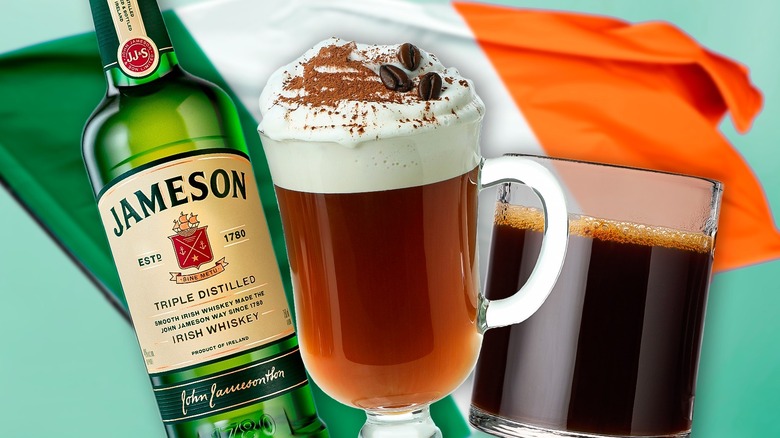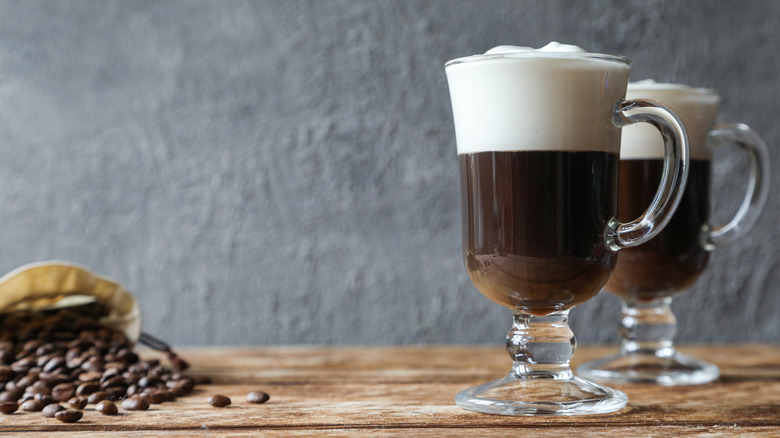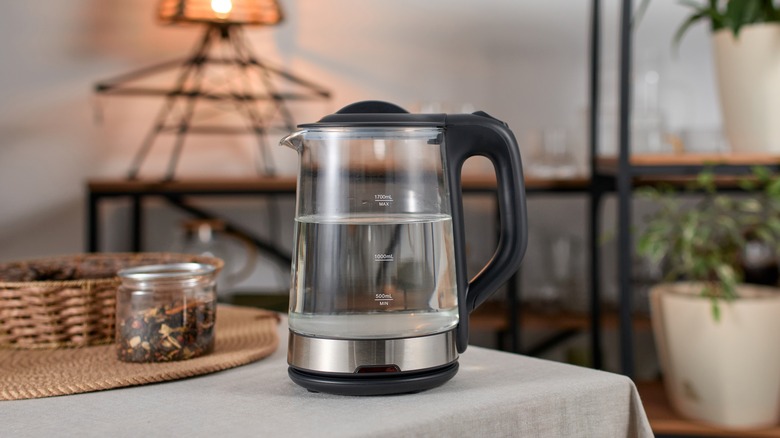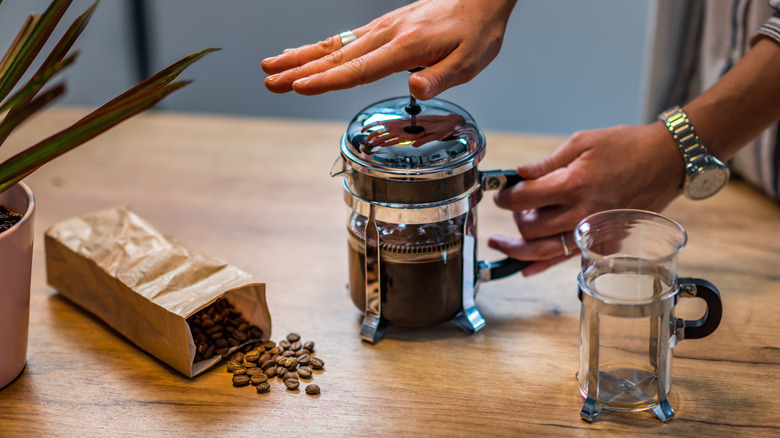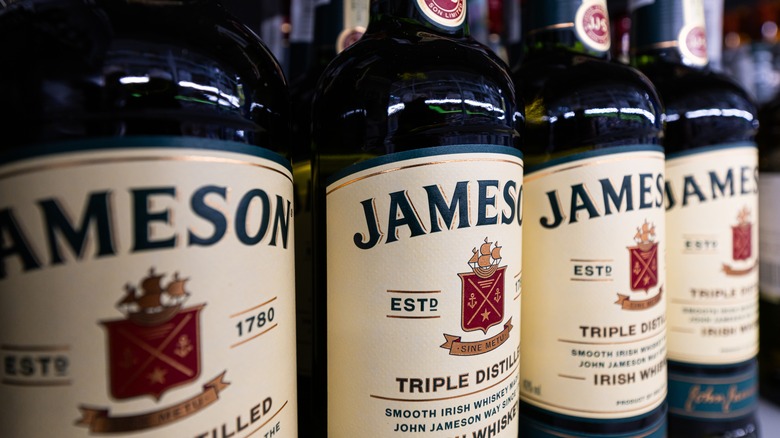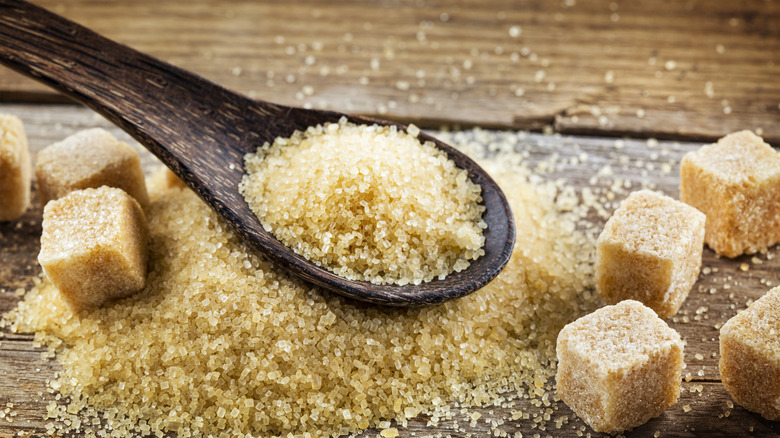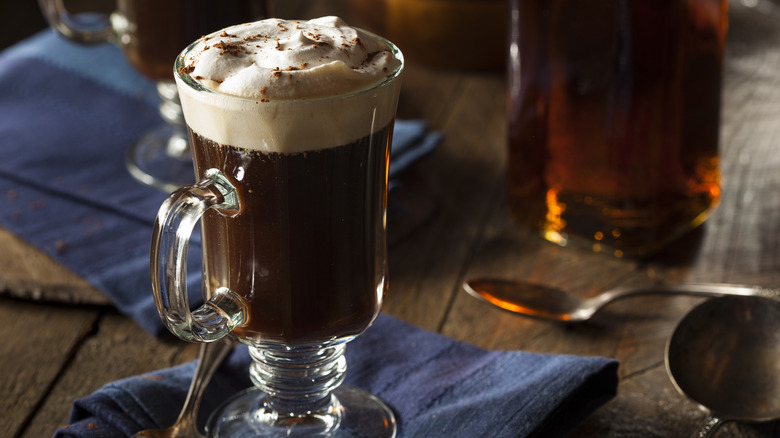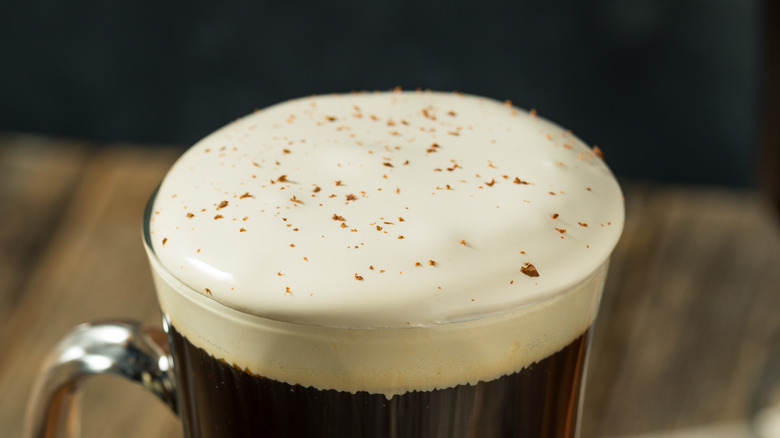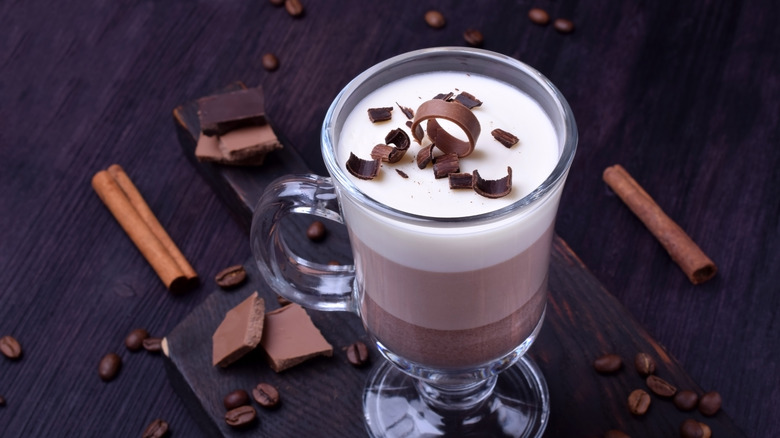10 Tips You Need When Making Irish Coffee
On a cold winter's evening, few drinks are better suited to warming both the body and spirit than a well-made Irish coffee. Like many other classic cocktails, part of the beauty of an Irish coffee lies in its simplicity. And though it comes with a slightly murky background, as well, most agree the drink was invented in the early 1940s in Ireland before being popularized in the U.S. at Buena Vista Cafe in San Francisco.
Of course, while it can be hard to differentiate between the truth and a marketing ploy — and I've become slightly cynical about the origin stories of drinks, consequently, during my many years working as a professional bartender and bar manager – the precise history of the Irish coffee isn't all that important. After all, what matters is that the cocktail presents the perfect marriage of hot, sweet coffee and Irish whiskey topped with a delicate crown of cream.
Now, Irish coffees may be simple on paper, but they can be tricky to master — especially without knowing a few tricks of the trade. I'll be the first to admit I made some truly awful ones when I started my bartending career. Thankfully, I was able to eventually master the drink through knowledge and practice, and what follows is a list of everything I learned the hard way. To help you can craft top-notch Irish coffees with ease, here are 10 tips you need when making the classic warm cocktail.
Choose the right glassware
Some drinks have become iconic enough to warrant their own type of glassware. Mint juleps have the julep tin, Moscow mules have those copper mugs, and Irish coffees have...well, I'm pretty sure it's just called an Irish coffee mug. Unlike standard coffee mugs, Irish coffee mugs have a stem and are made entirely of thick glass. They tend to have a sturdier base than other cocktail or wine glasses because they're heavier (and accidentally spilling a hot drink is arguably more disastrous than knocking over a cold one).
Using the proper kind of glass for an Irish coffee is important for a couple of reasons. First, when Irish coffee is made correctly, it's a visually striking drink, and glass is the best way to show off the stark contrast between dark coffee and perfectly layered cream. The glass is also thicker than the stuff used for regular cocktail glasses since it better insulates heat. This keeps the drink warmer for longer and reduces the risk of burnt fingers, while making it less likely to crack from a sudden change in temperature. Additionally, Irish coffee mugs often come in a standard 8.5-ounce size to make it easier to get the correct proportions.
Of course, if you don't have an Irish coffee mug, it's not the end of the world. However, for the reasons mentioned above, you shouldn't just substitute any other cocktail glass, and it's better to stick with a regular ceramic coffee mug.
Preheat the glass first
When you make a cocktail, you typically want the drink to stay as close to its initial temperature for as long as possible. This ensures whoever's enjoying it can take their time. For cold cocktails that aren't served with ice, bartenders often chill the glass while they mix the drink, so the liquid remains cold over time. The principle is the same for an Irish coffee, except we want to heat the glass up instead.
The best way to preheat your Irish coffee mug is to simply fill it with hot water while you prepare the rest of your ingredients. A coffee machine with a hot water mode offers an easy option. If you need to boil the water yourself to make your Irish coffee, though, you can use this water, as well, as long as you remember to make extra to heat the glasses.
There's also a backup solution if you forget to boil enough water — assuming your Irish coffee mugs are microwave-safe, that is. While it's possible to preheat the mugs in the microwave, not all Irish coffee mugs are safe to use in the appliance (at least in my experience), so it's worth double-checking. If you're not completely certain, don't attempt it, as it's not worth the risk. Otherwise, you can fill the glass about ¾ full of water, and microwave for up to a minute.
Make the coffee strong
The key to any good cocktail is balance. The ingredients need to harmonize so no flavor overpowers any other — and it's no different with Irish coffee. This drink only features two base ingredients of whiskey and coffee, after all, both of which are known for intense flavor profiles. You can certainly adjust the amount of whiskey you use, but that won't matter much if you don't properly brew the coffee.
Ideally, the coffee should be as strong as you can make it without it tasting astringent. If it's too weak, the alcohol in the whiskey may be too pronounced, and a great Irish coffee should taste like whiskey without be overly boozy. Additionally, although a dark roast is fine if you're using a stronger–tasting whiskey, a medium roast coffee is going to give you the best balance of flavors for Irish coffee.
When I'm making Irish coffee at home, I prefer to use a French press to ensure my coffee packs enough punch. If I'm making it at a bar, though, this method isn't particularly convenient, so I opt for an espresso machine when possible. You can also use an espresso machine at home since you're essentially making a double-shot Americano. Just add the espresso to the water you've used to preheat the mug. This is actually better, too, because the water will have time to cool slightly (and won't burn the fresh coffee).
Pick a quality whiskey
An Irish coffee is no different from any other cocktail. A low-quality liquor can easily make a bad drink ... yet there's a point of diminishing returns when it comes to premium-priced spirits. After all, the nuanced flavors you find in a super expensive bottle of whiskey are apt to be lost when you mix it with coffee.
Now, while it ultimately comes down to your personal preference, my go-to picks for Irish coffee are usually classic Jameson or Tullamore Dew. Each is dependable, versatile, and a great value for money. Jameson has a spicier profile and a bit more kick to it, while Tullamore Dew is a bit sweeter and softer, with more pronounced caramel notes. Teeling Small Batch is another great (if slightly more expensive) choice when you want a stronger whiskey with lots of dried fruit character. Of course, if you really want to treat yourself? I can't suggest a better option than Redbreast 12 Year.
Full disclosure: Redbreast 12 Year is my all-time favorite Irish whiskey, so I may be a little biased. But the single pot still whiskey is exceptionally rich, complex, and works wonderfully in an Irish coffee. The whiskey's got something of a Christmas cake character, with bold notes of honey, raisins, toffee, and plenty of baking spice that make it a superb pick for a decadent Irish coffee.
Dark sugar will improve the flavor
No Irish coffee is complete without sugar. Part of this is technical (which I'll get to later), but it's also crucial for balancing the bitterness of the coffee and tempering the bite of the whiskey. In short, sugar brings the core components together, letting their flavors shine. While there are many types of sugar to choose from — and regular white sugar will get the job done — darker styles tend to be superior.
The rich, complex flavor profiles of darker sugars better complement the robust coffee, while helping enhance the whiskey's sweet notes. Brown sugar introduces a hint of molasses to your cocktail, for instance, while boosting the caramel flavors. Demerara is a similar option that introduces a deeper toffee element. If you like your Irish coffee bold, muscovado sugar dials the caramel and molasses notes up to 11 and contains a slight bitterness that prevents the drink from tasting too sweet.
Also, avoid using sugar cubes because they take a while to dissolve properly (I regularly find leftover granules stuck to the bottom of the glass when cubes are used). Granulated sugar is fine, but there's no substitute for sugar syrup with Irish coffee. It's already dissolved, so just have to pour it into the coffee and give it a quick stir. Sugar syrup is also just a 1:1 mix of sugar to hot water, meaning it's incredibly easy to make.
Experiment with different sweeteners for a unique twist
Trying out different types of sugar will undoubtedly enhance the inherent flavors of your Irish coffee, but it won't dramatically change them. If you want to put more of a twist on the drink, then, your best bet is to try out a different sweetener altogether. Plenty of folks use maple syrup or honey as a natural sweetener in coffee, and these can also work just as well in the boozy version. Most flavored coffee syrups can even be added to Irish coffee — as long as you remember they need to pair well with the whiskey, too.
Flavors like vanilla, caramel, and hazelnut are a perfect match for a coffee and whiskey combo, but beware: these syrups are typically quite strong. Use too much, and you risk losing the nuances of the whiskey, so less is always more. If you need to increase the sweetness without intensifying the additional flavor, you can always add some standard simple syrup to balance things out.
My favorite secret sweetened ingredient for Irish coffees is gooey condensed milk (although I suppose it's not so secret anymore). It introduces the right amount of sweetness to the drink, making it perfect for people who prefer to drink milky coffee. I personally take my coffee black, but condensed milk offers an excellent way to introduce Irish coffee to those who like a more mellow drink.
Skip canned whipped cream
I'm not sure when people started making Irish coffees with canned whipped cream, but I wish they'd stop. After all, an Irish coffee is supposed to look simple and elegant — not resemble a child's hot cocoa. In other words, an authentic Irish coffee should be made with layered heavy cream, and for good reasons.
First, the hot and boozy concoction is supposed to pass through the top layer of heavy cream when you drink it, melding the flavors together. Furthermore, real cream adds a silky texture to the drink that you simply can't get with canned whipped cream. Now, I realize getting heavy cream to float on coffee is a challenge, and I understand why it's tempting to take the easy way out. However, there are a few options to make this part easier. For instance, you can lightly whip the cream if needed, since you're not aiming for stiff peaks; rather, you just want to thicken it slightly and introduce a touch more air to help it stay afloat.
Additionally, if you recall, I mentioned there was a technical reason for adding sugar to Irish coffee ... and this is it. Adding enough sugar (or another viscous sweetener) ensures the coffee is denser than the cream so the cream stays afloat. If you're still struggling to work with non-whipped cream, then, try adding more sugar.
Use a spoon to float the cream
Even with enough sugar, getting the cream to float perfectly on your Irish coffee can be tricky. Fortunately, there are a few techniques to help you achieve perfect separation every time (as long as you put in the practice to perfect it).
The easiest method is to use a regular metal spoon. Turn it upside down so it's convex-side-up and hold it over the coffee. You want the rim of the spoon barely touching the side of the Irish coffee mug, and barely touching the liquid below, too. Next, gently pour your cream over the back of the spoon to disperse the cream more slowly over a wider surface area, allowing it to float on the coffee. Gently raise the spoon as you pour until the cream has reached the top of the glass, and the job is done.
Of course, if you want to add a touch of flair to your layering technique, you'll want to grab a bar spoon. Make sure it has a twisted handle, and that it has a flat metal disk on the end. Hold the spoon vertically and upside down, so the disk barely touches the liquid's surface. Slowly pour the cream into the spoon at the top, and it will run gently down the spiral handle before spreading out over the disk. Although this method is a bit trickier to master, it has the same effect as using the back of a spoon.
Don't skimp on the garnish
There's a saying in the hospitality industry that can be traced back to ancient times: the first bite is with the eyes. Now, in the bartending world, we swap out "bite" for "sip" — but the premise is the same. First impressions matter, in other words, and garnishes catch the eye while demonstrating attention to detail. They tell the drinker that care has gone into preparing their drink and, more often than not, they also enhance the aroma and flavor of the cocktail. So, while Irish coffees are simple and elegant beverages, any garnish you choose should match this aesthetic.
Now, if you don't want to change the flavor of the drink, I suggest sticking with an espresso martini approach, and gently floating three whole coffee beans on top of the cream. Personally, though, I like to dust the top of Irish coffees with something that hits the nostrils with an inviting scent — enticing the drinker before their lips even touch the glass. You can't go wrong with a light dusting of freshly grated nutmeg or cinnamon, or perhaps a pinch of cocoa powder.
Chocolate shavings are another excellent garnish choice, as they melt beautifully into the cream and add an unobtrusive chocolatey flavor that doesn't get in the way of the stark coffee and whiskey. A light orange peel zest can also work wonders, as it brings a brighter aspect to the cocktail while still complementing the base ingredients.
Get creative with your recipes
While there's something to be said for the stunning simplicity of an Irish coffee, experimentation with the classic formula can reap delicious rewards. The biggest change you can make is swapping out the base spirit for something else — although if you don't use Irish whiskey, it's not technically an Irish coffee anymore.
For example, using Scotch whisky gives you a Gaelic coffee, which tends to be a more spirit-forward drink (especially if you opt for a peated expression). Meanwhile, swapping the Irish whiskey for American bourbon results in a slightly sweeter Kentucky coffee with more pronounced caramel notes. And while some folks like to swap out the whiskey for a sweet liqueur, there's no reason you can't use both. Hazelnut liqueurs like sweet Frangelico offer a luscious, Nutella-like spin on the drink, while opting for a high-quality Irish cream liqueur gives it a creamier mouthfeel and boosts the chocolate notes.
Orange liqueurs, such as Cointreau, add a warming citrus aspect to Irish coffee, or you can try an amaretto upgrade for a wintery, marzipan-esque flavor. Plus, don't forget about the magic of cocktail bitters, either. Just a few drops of the right tincture can transform an Irish coffee without having to change the standard recipe. I typically add a few dashes of cocoa bitters to mine, but the options are nearly limitless. Frankly, if you're feeling especially creative, why not try adding more than one additional ingredient?
